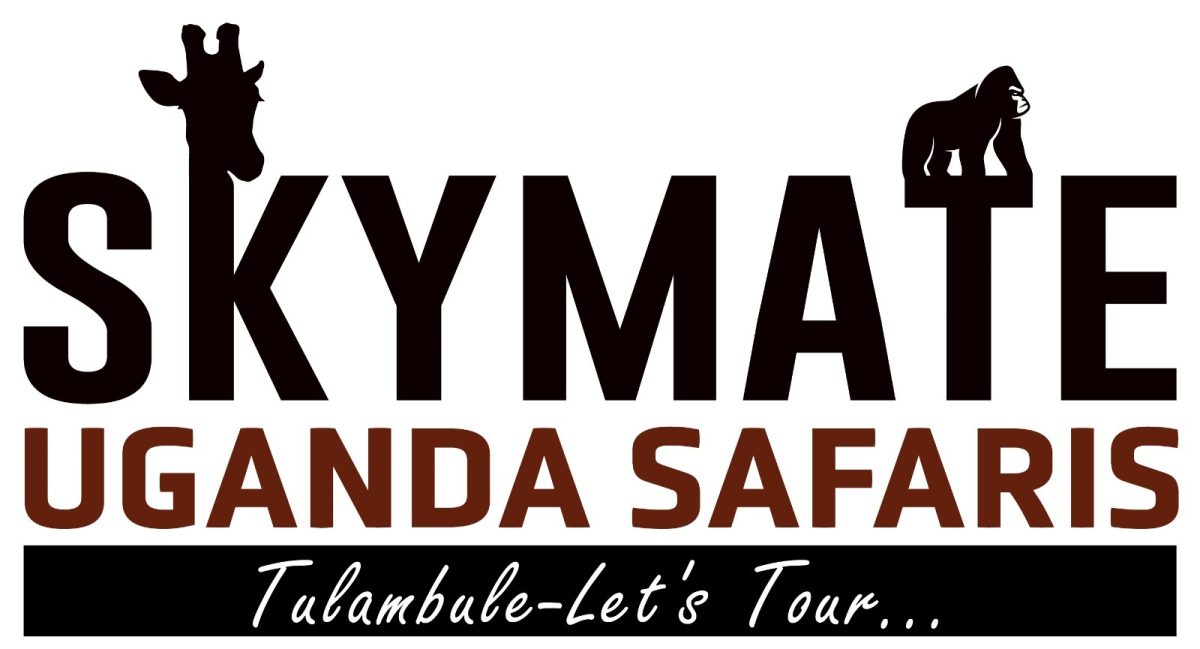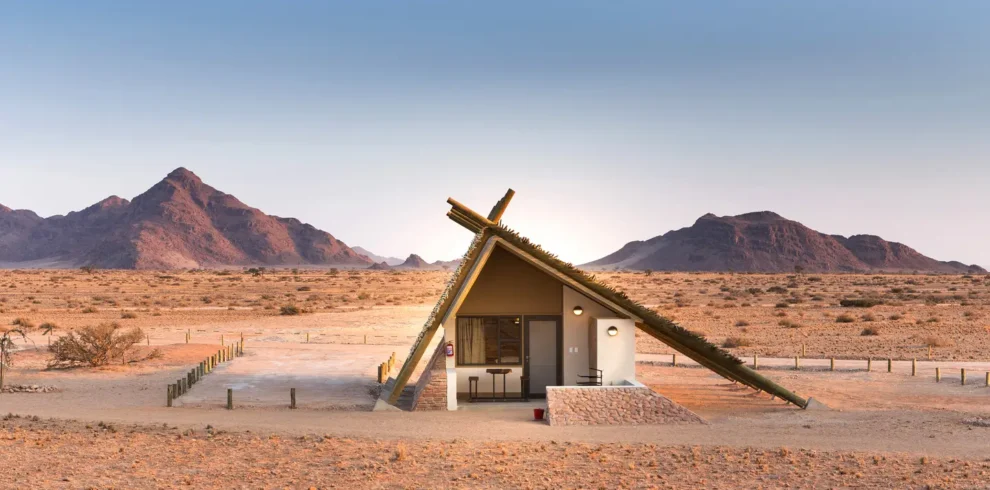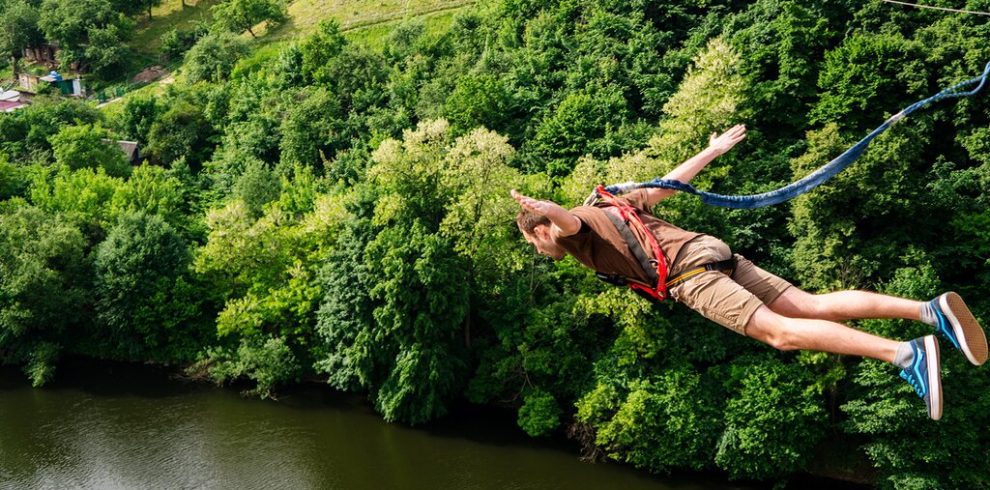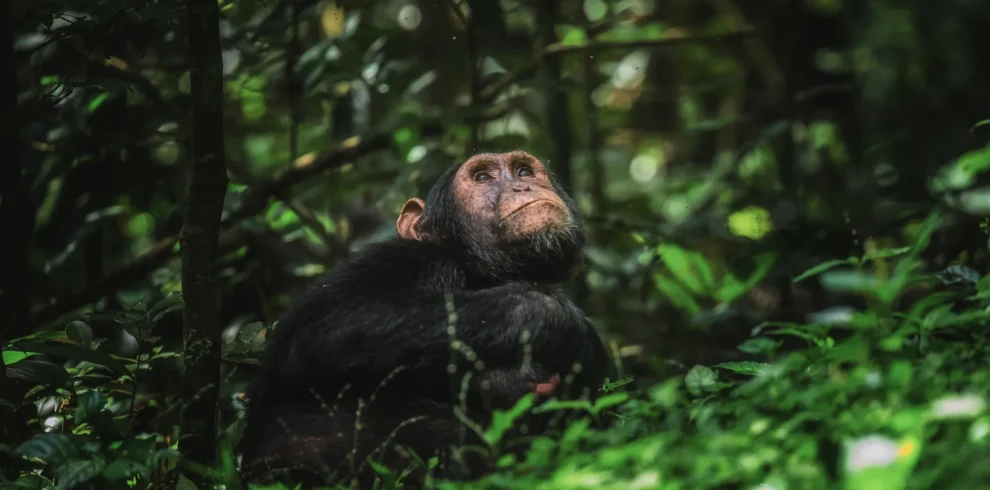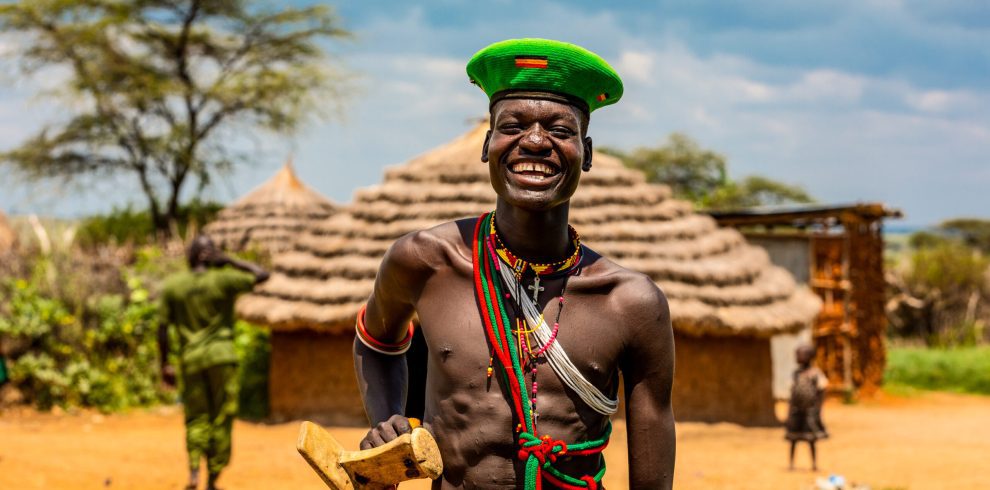This 13 Days Best of Namibia safari tour takes you many of Namibia’s must-see attractions, as well as including authentic cultural experiences with the indigenous people of this wonderful nation.
Namibia truly is the perfect destination if you are looking for a mix of rich wildlife, wonderful landscapes, genuine culture and fascinating history. Besides that it is also a safe country, with friendly people and a well-established tourism infrastructure.
First, you will tour Okonjima Nature Reserve, before an enriching cultural encounter with the Bushman or San people. Okonjima Reserve is home to the AfriCat Foundation and one of the best places in Namibia to see the Big Cats. Next, you will for a three day safari in Etosha National Park, without doubt one of the best game viewing destinations in Africa.
After Etosha, you will enjoy another enlightening cultural encounter, this time with the Himba tribe of northern Namibia.
Then the safari continues south towards rugged and dramatic Damaraland, before travelling to coastal holiday town of Swakopmund through the unusual Skeleton Coast.
Last, but not least, you’ll enjoy the vast Namib Desert, that includes iconic Sossusvlei, home to some of the highest sand dunes on Earth.
Itinerary Summary
Day 1: Arrival in Windhoek
Day 2: Okonjima Plains Camp, Okonjima Nature Reserve
Day 3: Grootfontein
Day 4-6: Etosha National Park
Day 7: Twyfelfontein
Day 8-9: Swakopmund and Living Desert
Day 10-11: Sossusvlei and Namib Desert
Day 12: Return to Windhoek
Full Itinerary
Day 1: Arrival in Windhoek
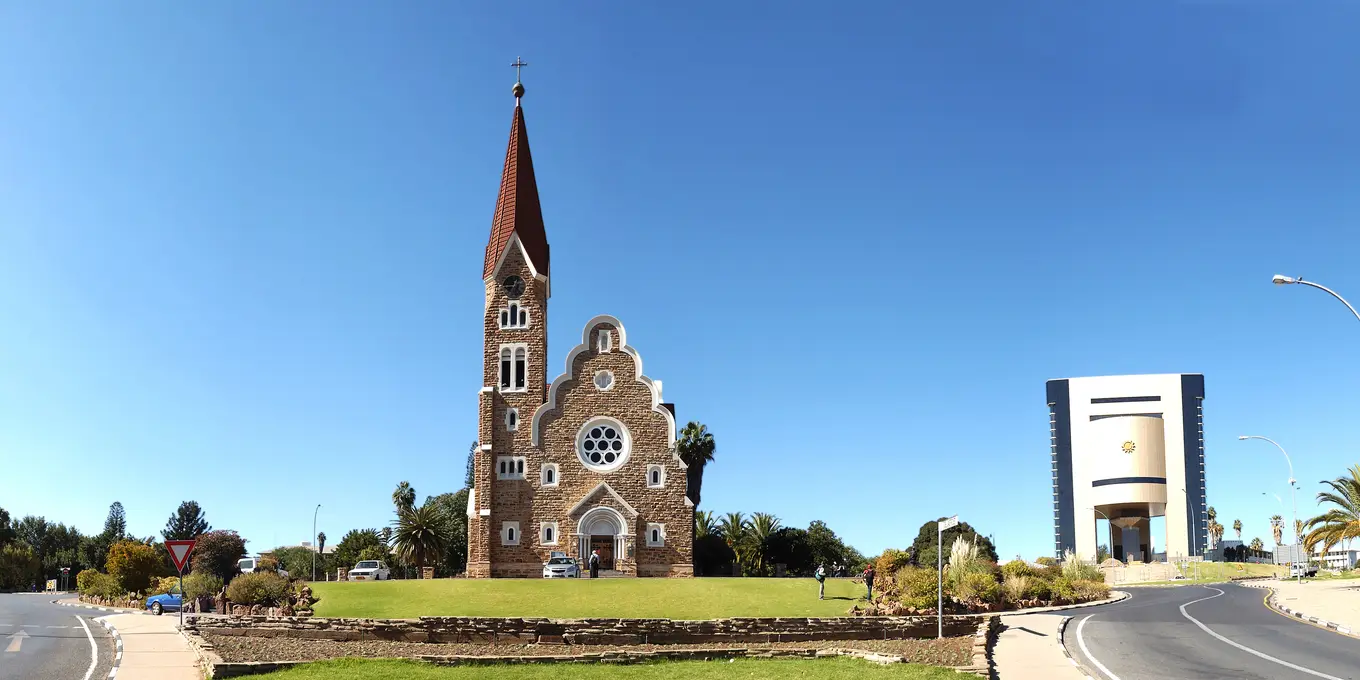
Welcome to Namibia! On arrival at Hosea Kutako International Airport outside Windhoek, the country’s capital, our company representative will be waiting for you in the arrivals hall of the airport with your name on a signboard.
After loading your luggage into the vehicle, you will be taken on a drive of about 45 minutes to your hotel in Windhoek.
Windhoek is encircled by magnificent mountains, extensive valleys, fertile farmlands, lodges and luxury guest farms. The landscape here is characterised by vast valleys, thick scrub, rocky hills, and covered in golden savannah.
It sits at 1,700m above sea level (12th highest capital in the world) in the Khomas Hochland plateau area. It is home to around 400,000 people at a low density of only 63 people per square kilometre. You’ll have dinner at one of the restaurants in Windhoek and rest up for the adventure to come!
Day 2: Okonjima Plains Camp, Okonjima Nature Reserve

Today, our guide will pick you up from the hotel and take you for a Windhoek city tour. After that, you will be driven north to Okonjima Lodge.
On arrival, enjoy your first game drive in Namibia. Okonjima Plains Camp found within the private wilderness area of Okonjima Nature Reserve and has majestic sunset views.
It has accommodation facility of 10 large View Rooms and 14 spacious Classic Rooms. The Plains Camp Barn also includes a dining and lounge area, and a terrasse with views over a waterhole and the Okonjima plains.
Look forward to game drives in search of Leopards and guided bush walks offering intimate, up-close views of Namibia’s wildlife.
Whether you hike or are an avid bird watcher, there are many ways to spend your time at Okonjima. Okonjima Reserve is also one of the premier places to stay to witness carnivores and other endangered species such as Pangolin, Aardvark, and Brown Hyena and to be educated about conservation.
Day 3: The San People – Bushmen

As the African sun rises, enter an open safari vehicles for another game drive in Erindi.
Search for all the Big Game, but also look out for smaller creatures like Caracal, Bat-eared Fox, Serval, Black-backed Jackal, Yellow and Banded Mongoose, Meerkat, Common Warthog and more.
Erindi also has over 300 bird species, and some of the specials include Crimson-breasted Shrike, Ruppell’s Parrot and Rosy-faced Lovebird.
After a full breakfast, drive northeast for about 5 hours, to one of Namibia’s most remote corners – and home to the San people. After a quick stop to admire the largest known intact meteorite on Earth at Hoba, enjoy lunch in Grootfontein Town. Then continue to Roy’s Camp where you will spend the night.
Roy’s Camp, is situated on a game farm and is the perfect base from which to explore and spend time with the Bushmen/San people.
The San are hunter-gatherer people, indigenous to southern Africa, who are very successful at surviving in the bush and desert despite their limited technology and weaponry.
They belong to the Khoisan group that speaks the “click” languages. They are well-known for their rock engravings and researchers’ interpretation of the San people is that their beliefs and rituals are very much a part of their art.
Day 4: Bushmen and off to Etosha National Park
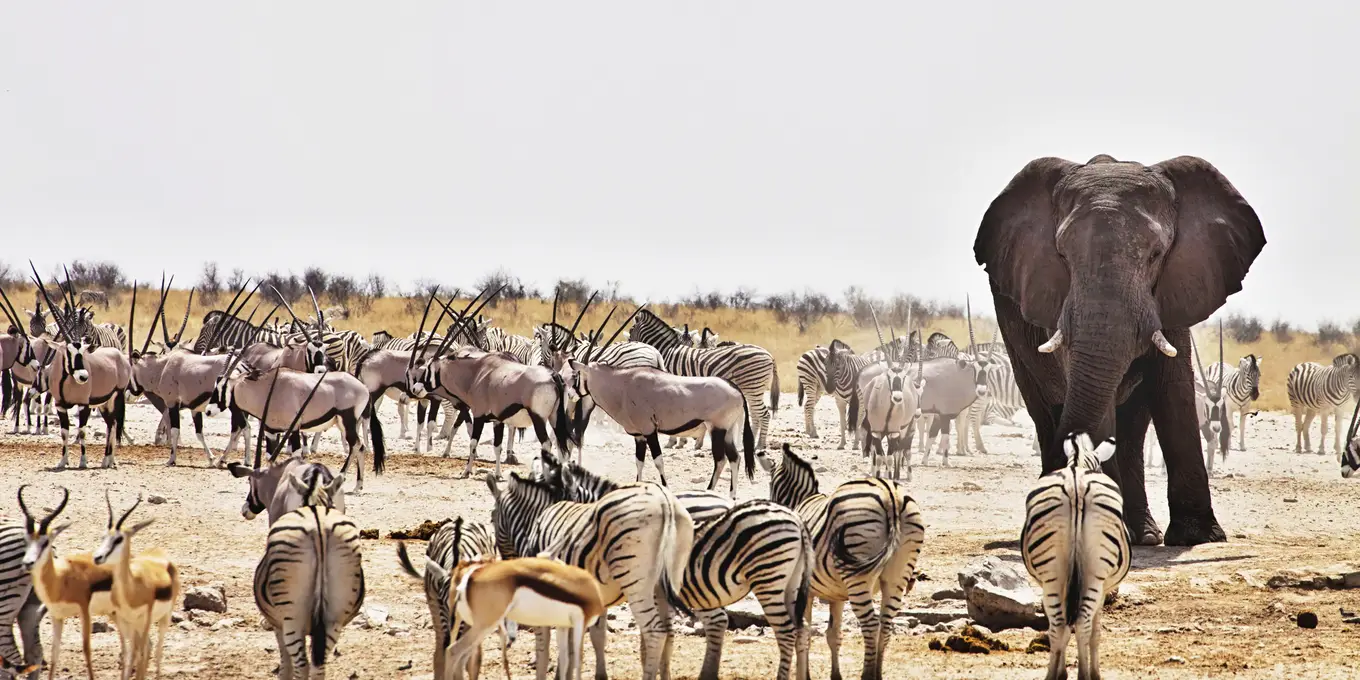
After an early breakfast go to meet up with the Ju/’hoansi Bushmen, who live in small villages scattered across Bushmanland. After a quick introduction and greeting ceremony, set off into the bush with the village hunters.
Spend most of the morning with them, looking for prey to shoot with their poisoned arrows, as well as for edible roots, berries, honeycombs and whatever else would be welcomed by the rest of the villagers.
It is a fascinating experience walking with these men, whose knowledge of the bush and all its inhabitants is simply astounding.
Break for an early lunch before you have your interaction with the women of the village this time.
Their job, among others, is to process whatever the hunter-gatherers brought back to the village this morning. If you are lucky and it was a good bounty, you might even witness one of their original, traditional, singing and dancing celebrations.
In the afternoon you will make your way northwest for about 3 hours to your next exciting destination; the Etosha National Park!
Day 5-7: Etosha National Park
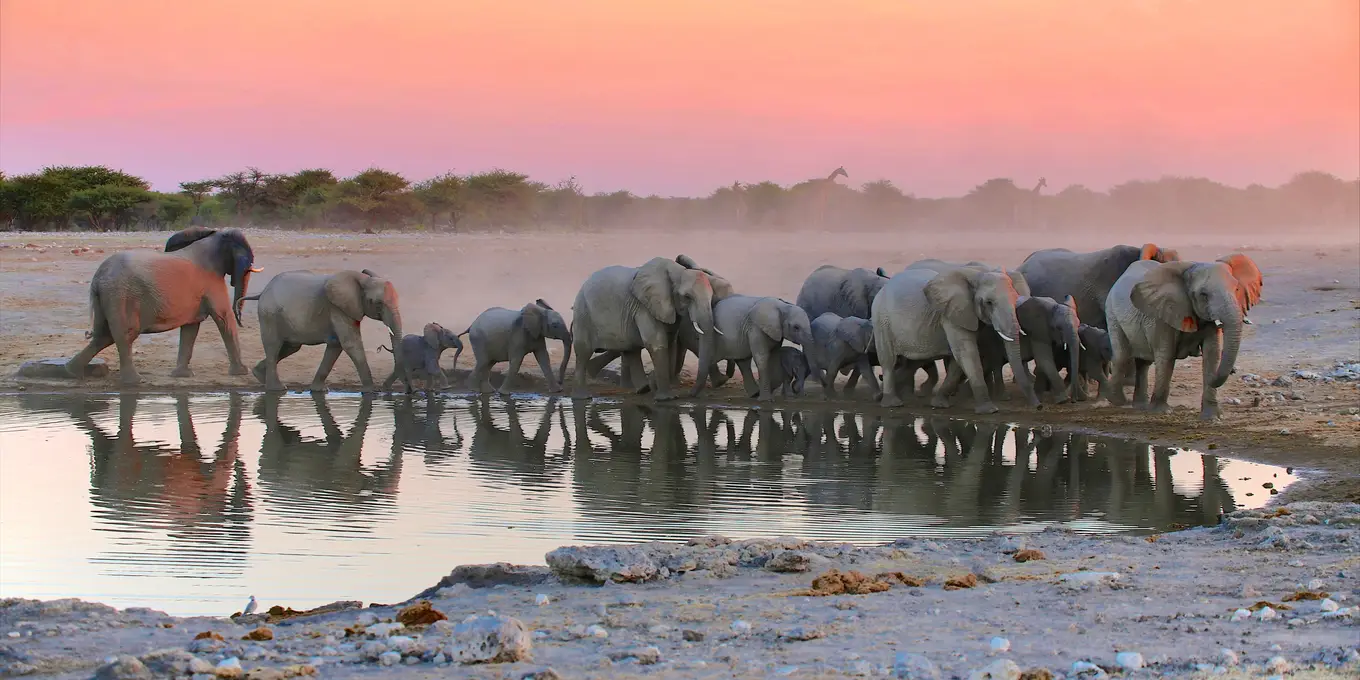
You will have three days of game viewing in the world famous Etosha Park.
Certainly one of Africa’s great parks, the vast Etosha National Park in north-central Namibia covers over 22,300 km2 and is synonymous with big game and wide-open spaces.
The name Etosha actually means “great white place” referring to the massive dry pan in the middle of the park, believed to have been formed approximately 100 million years ago.
Etosha is home to a staggering amount of African wildlife, both common and rare, including several threatened and endangered species.
The mammal list is at over 110 species, including four of Africa’s Big 5, Cheetahs, Giraffe, Spotted Hyenas, Zebras, Kudus, Springbok, Gemsboks, Warthogs, Honey Badgers and more. It is the best place in the world to see Black Rhinos.
In the drier months of the year, nearly all the animals tend to gather around the waterholes dotted around the huge park.
They come to drink water and are inevitably followed by predators; this allows you to sit and wait at some of the waterholes and wait for the action to come to you.
This is what sets Etosha apart from other parks of Africa; unique indeed!
Day 8: The Himba
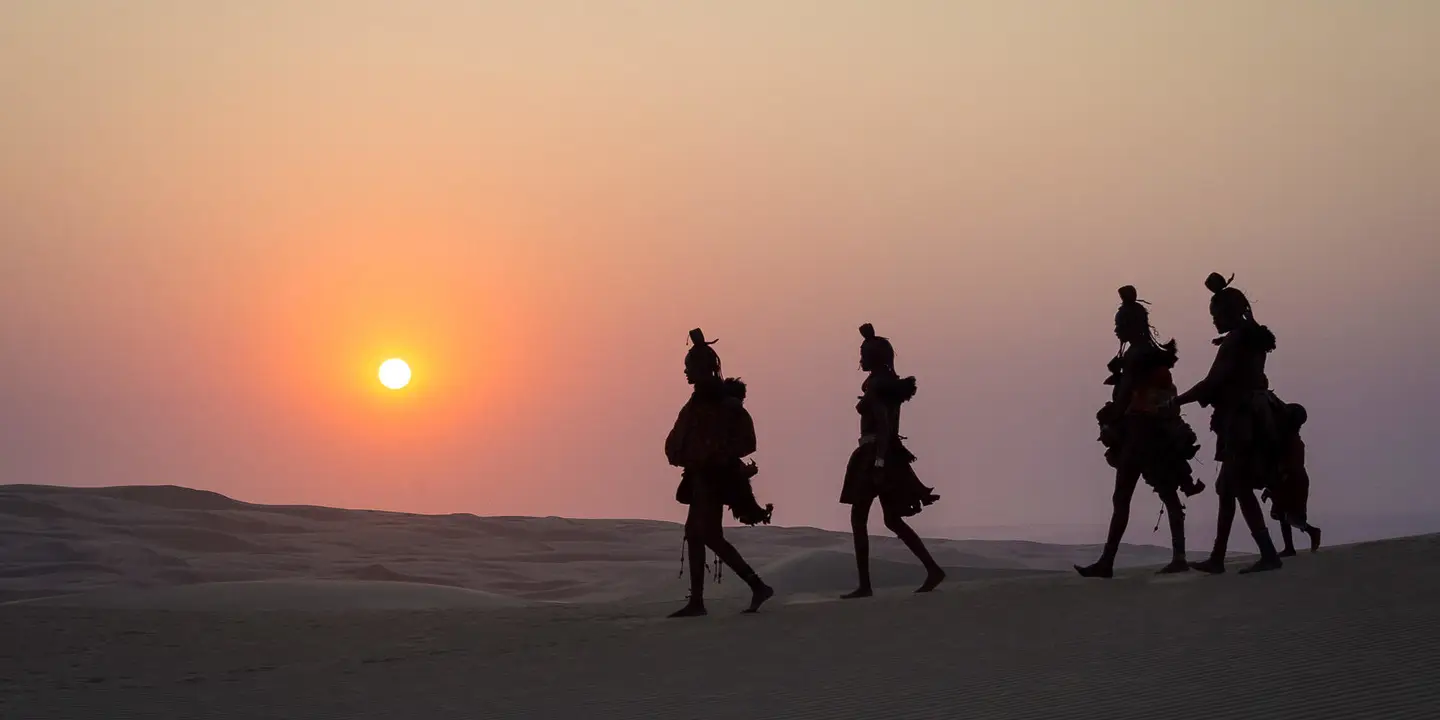
Leave Etosha relatively early this morning and make your way further north to a small town called Opuwo, about 4 to 5 hour drive.
You will have a stopover for any exciting wildlife sightings along the way or if we see some beautiful landscape features.
Opuwo is the only bigger town to be found in the Kunene region and is an ideal stopover when travelling north to the stunning Epupa Falls. The only airport of the region is found here, offering the option of fly-in safaris.
Kunene is home to the Himba tribe who seem to survive in this stark desert landscape. The Himba, one of the last true nomadic tribes on Earth, is a highlight on any visit to the region, with their intricate customs and traditions, ochre-covered bodies and elaborate jewellery.
They are pastoral people. Like East Africa’s Maasai people cattle are the central and most important feature of their lives, representing status and wealth. You will arrive in time for lunch and the entire afternoon is dedicated to our interaction with the fascinating Himba people.
Day 9: Damaraland
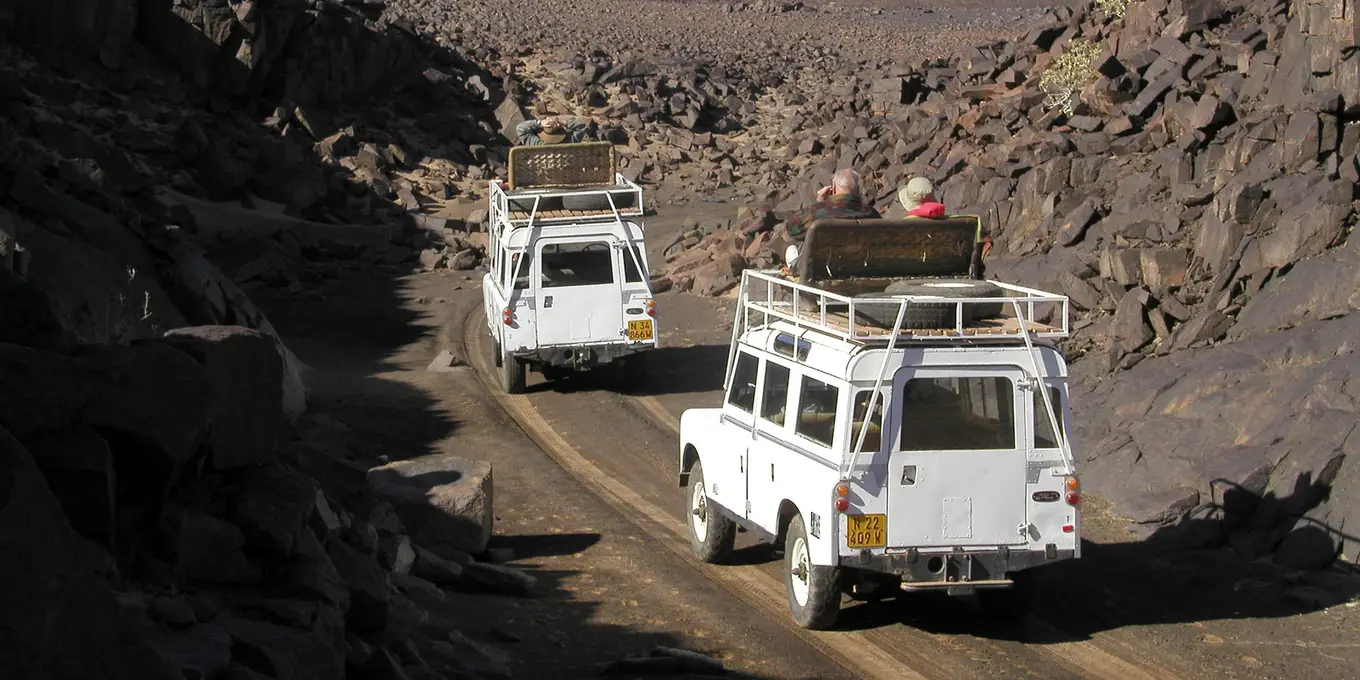
After breakfast this morning head directly south.
It is a long drive to your next destination, but the road trip will be worth it. You will traverse dry riverbeds and rocky plains and jaggedly beautiful terrain when you reach the edge of Damaraland.
This beautiful mountainous region features an assortment of scientifically important desert adapted wildlife such as African Elephant, Black Rhinos and Lion, which somehow survive and thrive in this near-barren landscape.
After a picnic lunch en route you will stop and admire the “petrified forest” rock formation, believed to be over 200 million years old! Here you’ll also look out for the Namib Desert’s weird-looking living fossil plant, the Welwitschia, the longest living plant on earth.
Before you check into your lodge this evening, you will visit two more fascinating geological formations, the “organ pipes” arrangement and the much-photographed “burnt mountain” (a flat-topped mountain that derives its name from the piles of blackened limestone at its base).
After sunset you will freshen up and enjoy dinner in dramatic Damaraland.
Day 10: Skeleton Coasta and Swakopmund
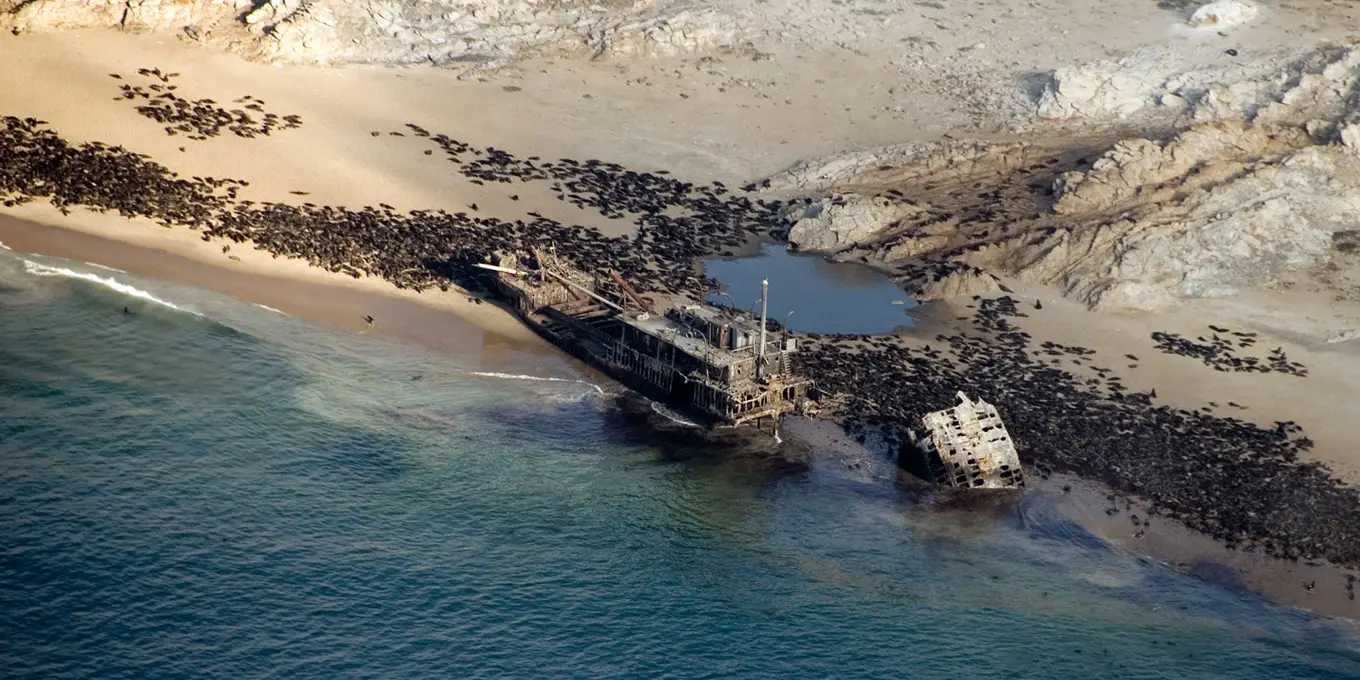
After breakfast, proceed southward to Twyfelfontein.
Meaning “uncertain spring” in Afrikaans, Twyfelfontein is a massive open-air art gallery that is of great interest to international rock art connoisseurs, and another of Namibia’s UNESCO World Heritage Sites.
The 2,000-plus rock petroglyphs, estimated to be 6,000 years old, represent one of Africa’s largest and most noteworthy concentrations of rock art.
From Twyfelfontein, you will visit the abandoned mining town of Uis and take a short break here for some photographs and learn about the history of mining in Namibia.
After that, you will drive past the Brandberg (literally “fire mountain”), Namibia’s highest mountain, with the highest peak at 2,573m above sea level.
Continue to the Atlantic Ocean coast, crossing the desolate gravel plains of the Namib Desert before arriving at the Skeleton Coast and having a roadside lunch break.
This desolate and hauntingly named area is one of the most unusual coastal wildernesses on the planet, protecting about a third of Namibia’s long coastline.
It has a longstanding reputation of being a perilous sea passage for sailors, and truly the Portuguese sailors used to call this area the “Sand of Hell”, referring to the fact that even if one did survive a ship running aground, the harsh desert would almost certainly provide one’s final resting place.
Explore some of the many shipwrecks along the coast and visit Cape Cross and its famous seal colony. It is the breeding place of over 200,000 South African Fur Seals. Besides seals, there are also other fauna to be seen here, including Brown Hyena, Black-backed Jackal, and Flamingo.
After these very informative excursions, continue south along the coast to Swakopmund, the first place that will feel like a town since you left Windhoek many days ago! After checking in at our hotel, explore this charming holiday town on foot before sunset.
Day 11: Living Desert Experience and off to the Namib Desert
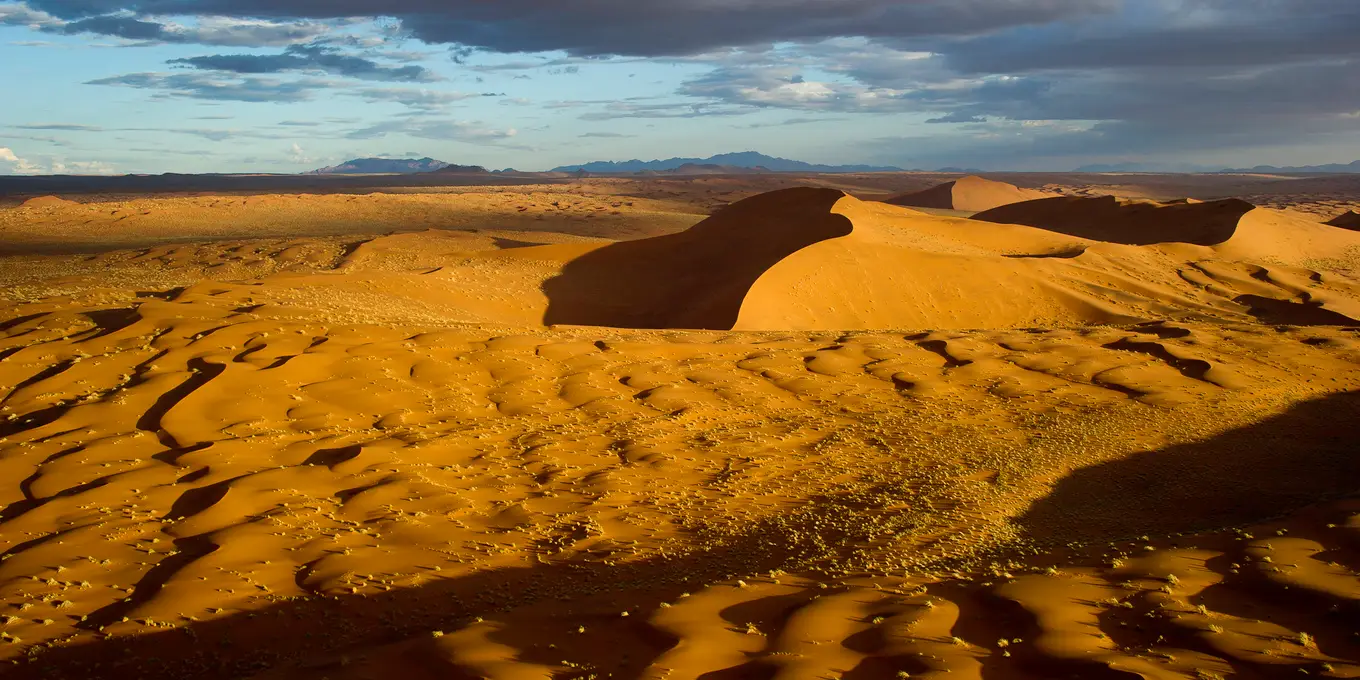
After a relaxed breakfast in Swakopmund, depart for a Living Desert Experience, a unique adventure indeed and a real eye opener!
Encounter and learn more about the fascinating wildlife of the Namib Desert with the help of a local expert. This seemingly lifeless environment supports a wealth of animal and plant life that have adapted in wonderful ways to survive and thrive here.
Look for geckos, scorpions, snakes, skinks, lizards, birds and beetles as well as the incredible plant life that survives in this harsh environment.
After a quick stop for lunch, be in the vehicle and make your way further south toward iconic Sossusvlei, turning inland and traversing the vast Namib-Naukluft Park.
It is the only coastal desert in the world that includes extensive dune fields influenced by fog. Covering an area of over 3 million hectares, the site has a unique environment in which endemic invertebrates, reptiles and mammals adapt to an ever-changing variety of microhabitats and ecological niches.
Day 12: Sossusvlei, Deadvlei and Sesriem Canyon
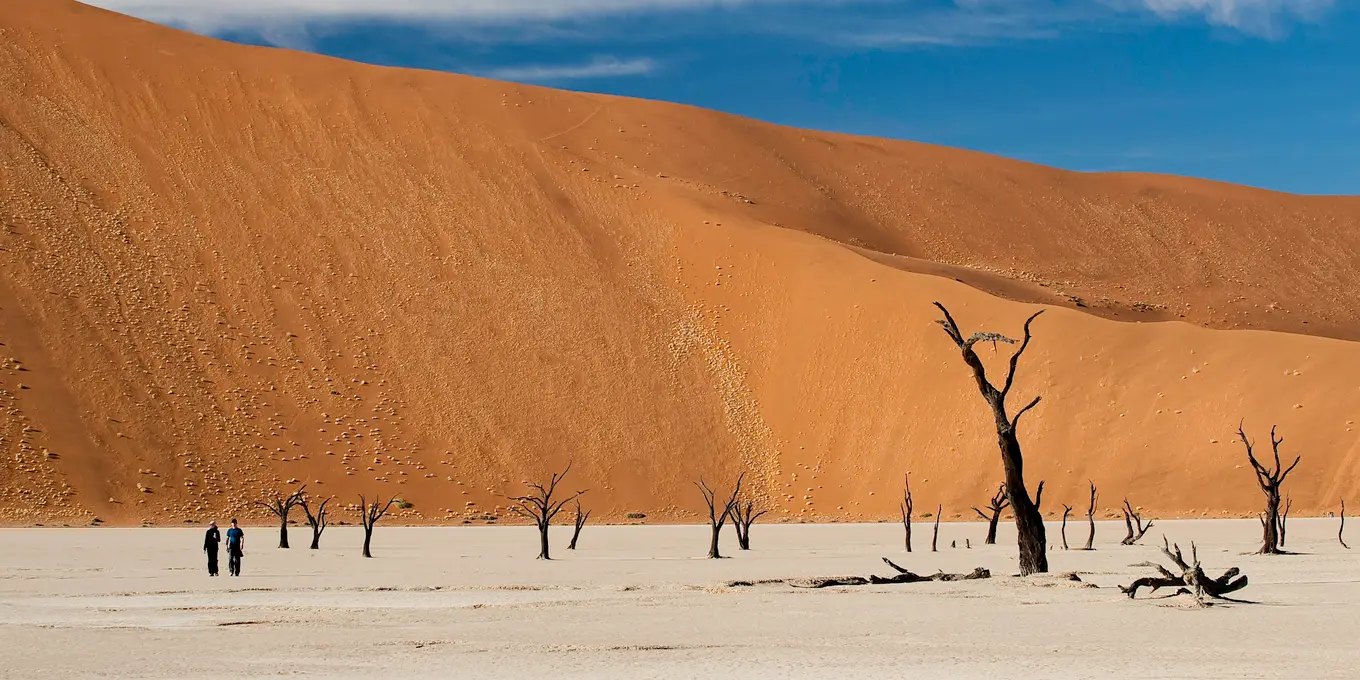
Again be up before the sun this morning, and be close to the world’s highest sand dunes by the time the first rays appear.
It is a magical place to be as the sun rises, with incredible photographic opportunities. Sossusvlei is where you will find the iconic red sand dunes of the Namib. The clear blue skies contrast with the giant red sand dunes to make this one of the natural wonders of Africa.
Your last excursion will be at Sesriem Canyon. It is a narrow gorge slashed into the earth by the Tsauchab River millions of years ago, and is located near the entrance to Sossusvlei.
It is an interesting place to walk. It will take most of the day to explore this wonderland, so you will only return to your lodge in the afternoon.
Day 13: Departure
After a relaxing final breakfast together we will depart for Windhoek.
It is a 5 to 6-hour drive northwards to the capital. We will drive through the Namib Desert for the last time. It is the oldest desert and boasts the highest sand dunes in the world.
We will drive up to the Khomas Highland via one of the many scenic mountain passes, and remember to keep an eye out for some wildlife before we reach Windhoek.
We might see Common Ostrich, Gemsbok, Pale Chanting Goshawk, Sociable Weavers or even a Greater Kudu. In Windhoek we will take you to Hosea Kutako International Airport for your homeward flight.
